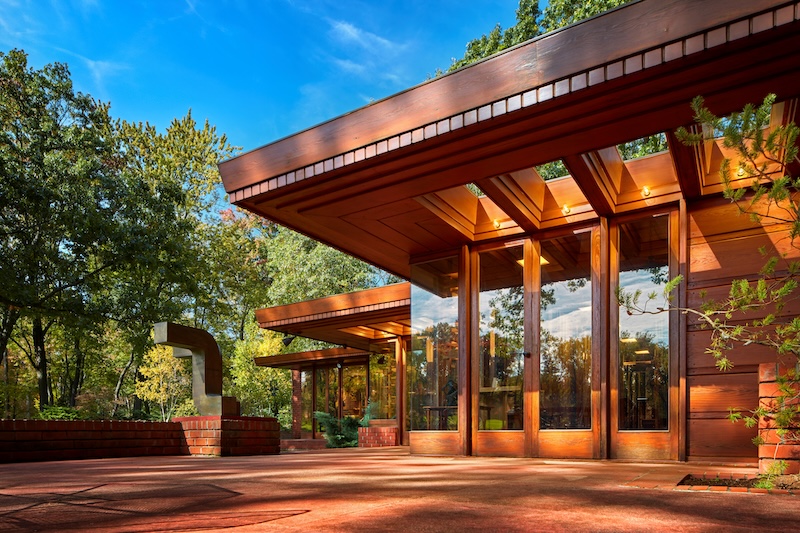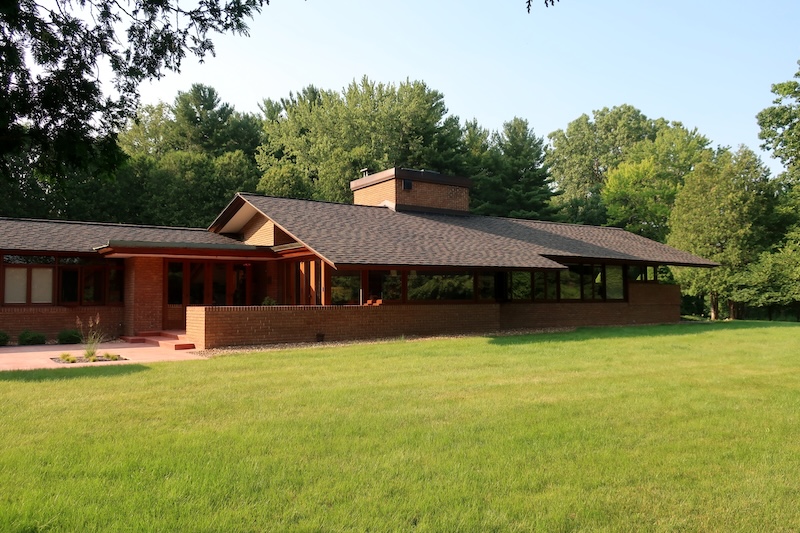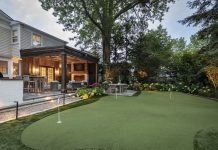If Norman Silk is right, the skies and sidewalks will fill with socks Sept. 25-29 when the comes to Detroit for its national conference. As many as 250 people are expected for tours, talks, walks, and special sessions т and Silk forecasts a тknock-your-socks-offт event.
тWe wanted our attendees to experience not only the refreshed Detroit but also to embrace the history,т says Silk, a local sponsor of the event along with his partner, Dale Morgan.
In addition to being business owners т of т the men are also owners of a Frank Lloyd Wright home. They received a Wright Spirit Award at a previous conference for the five-year restoration of their 4,300-square-foot Dorothy G. Turkel House, located in Palmer Woods on an acre and a quarter of garden beds and naturalized plots.
It is one of the six homes in southeastern Michigan that conference attendees and lucky ticketed members of the public can see pre- and post-conference. (The tours filled up soon after registration opened in May, but you can still get on the wait list and also register for other conference events at .) Tour attendees will also see works by Eliel and Eero Saarinen, Paul Rudolph, and William Kessler.
The conference is returning to metro Detroit for the first time since 2006, when it took place in Southfield. John H. Waters, the Chicago-based conservancyтs preservation programs manager, likes to remind people that Michigan is an important state in Wrightтs oeuvre, ranking third nationally in quantity after Illinois and Wisconsin with more than 30 of his buildings. Last yearтs conference was in Minneapolis.
тWe have a sort of rotation, and it was definitely time to get back to Detroit,т Waters says. This time, though, because of changes in the city, coming here тseemed like a no-brainer.т For him, as well as many other conferees who reserved rooms at the Westin Book Cadillac hotel, it will be the first time staying downtown. Fittingly for the urban setting, conference speakers will examine topics relating to Wrightтs concept of тBroadacre City,т which fundamentally concerns land use and urban planning in the age of the automobile.
тPart of the goal was to decentralize cities in what Wright saw as a positive way,т Waters says. Chicago, the home of Wrightтs practice in his early professional years, was тnot a particularly pleasant city.т But Wright wasnтt the only one pondering the subject. Le Corbusier would conceive his тRadiant City,т too, as part of тa larger movement to figure out how to create a livable environment for people.т
For the conferees, Wrightтs Broadacre concept could prove an interesting point of comparison with the new-and-improved host city. As Morgan puts it, тVisiting the multitude of houses that weтre going to be visiting,I think they will have a keen appreciation of the sophistication of the city of Detroit.т
Theyтll just have to go home without their socks.
Turkel House, 1955-58, Detroit

Owners: Norman Silk and Dale Morgan
т is one of what Wright called his тUsonian Automatics,тт says John H. Waters, the Frank Lloyd Wright Building Conservancyтs preservation programs manager. тThese were concrete-block houses. The blocks would be made custom for the building. Theoretically, the owner could build the building himself or herself. There is one house, the Pappas House outside of St. Louis, where the owners actually did construction т but Dr. Turkel, Iтm quite certain, did not. Itтs a particularly large house with a two-story living room thatтs great for music and entertaining. The current owners have done a fantastic job of bringing this house back to life. Norm and Dale are wonderful supporters of ours. The garden they have is fantastic.т
Silk and Morgan are florists, and they like to remind people that Wright once declared the garden to be the most important тroomт of any house.
тWe have a big Pewabic vase thatтs filled with leafy branches all summer long,тMorgan says.тTheyтre like 8 feet tall, so they end up towering over the space. And when you look out the windows, youтre seeing big trees with big leaves. It successfully blends exterior and interior so that it becomes a cohesive experience.т
Affleck House, 1941, Bloomfield Hills

Owner: Lawrence Technological University
тis one of a group of late-1930s to 1940 houses that were derived from an unbuilt design for Malcolm and Nancy Willey in Minneapolis,т says the conservancyтs Waters. тIt relates to several other houses of the period т the Pew House in Madison [Wisconsin], the Sturges House in Los Angeles, Kathryn and Lloyd Lewis outside of Chicago. These are all houses that are on unusual landscapes, unusual topography, and Wright raises the living area up over a sloped topography.т
тAn important feature of this is a cantilevered balcony, and the railing of this balcony has a series of lapped boards that create the parapet. That cantilevered balcony effect is not unlike Fallingwater, which is of course built out of concrete. But itтs doing something really similar in terms of cantilevering out over a natural landscape. Gregor Affleck was a good friend of Wrightтs from his youth.т
Smith House, 1949-50, Bloomfield Township

Owner: Cranbrook Educational Community
is тthe last of these tighter-budget Usonians that are mostly wood with only masonry cores,т Waters says. тItтs an L-shaped Usonian, which derives very directly from Wrightтs first Usonian, the in Madison. The Smiths had Taliesin Associated Architects, Wrightтs successor firm, do a small addition on the house. But it also has quite an extensive art collection, and now itтs under the stewardship of Cranbrook.т
Palmer House, 1950, Ann Arbor

Private owner
тA triangular grid creates a lot of 60- and 100-degree angles in the walls, so the walls donтt come together at 90 degrees, and it creates very interesting transitions in space,т Waters says. He adds that Wright thought 120-degree angles т тwhere the wall almost curvesт т were easier to maneuver around than sharper 90-degree angles.
тSo he used the triangle or the hexagon in a number of his later Usonians, and the is a great example of that. When you walk around in these houses, I kind of think heтs right! The Palmers were also [personally] very close clients to Wright. [The house] was underwritten by Mary Palmerтs parents and had a decent budget, so itтs very nicely detailed with some striking cantilevers on the rear of the house, what they refer to as тprow,т where I think itтs probably 60 degrees in plan and juts out at a corner to create a covered terrace.т
Goetsch-Winckler House, 1939, Okemos

Private owner
The is тa part of what was planned to be a development for a number of Michigan State faculty, including Alma Goetsch and Kathrine Winckler. This was the only one that was actually built,т Waters says, noting that a site was chosen for the development, which was intended to include approximately seven houses, but things didnтt pan out.
тGoetsch and Winckler had this house built on [1.7 acres]. Itтs one of the early Usonian houses, as is Affleck. Despite the small size of the house, the large living room has a very spacious feeling, so heтs manipulating a small space to its full effect. For the conservancy, Goetsch-Winckler is an important house because we did briefly own it in order to save it. We purchased it and eventually put a protective preservation easement on the house. The last couple of owners have done quite a bit to try to restore it, including an extensive exterior restoration, which our group has not seen before.т
Schaberg House, 1950 (design), 1958 (completed), Okemos

Private owner
тSchaberg is a later Usonian house,т Waters says. тWrightтs Usonian houses before the war, before 1941, 1942, were definitely focused on clients with a limited budget. The postwar ones tend to be larger. is a good example of that: Itтs a larger house. For instance, the living room т most of the early Usonians are flat-roofed. Schaberg has a dramatic, sloped living room roof/ceiling. Itтs just a little more high-end. And it also has a sensitive addition by an architect named John Howe, who was Wrightтs right-hand person from the 1930s on т often called тthe pencil in his hand.тт
This story originally appeared in the September 2024 issue of ЯуИлСљКЯВЪЭМПтзЪСЯ magazine. To read more, pick up a copy of ЯуИлСљКЯВЪЭМПтзЪСЯ at a local retail outlet. Our will be available on Sept. 6.
|
| Ь§ |
|








